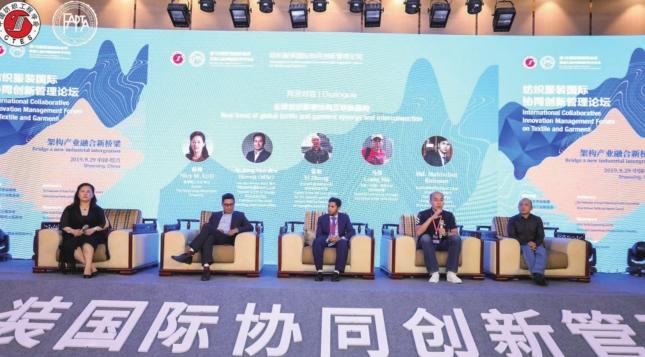Gathering international innovation and wisdom to bridge a new industrial integration

“2019 International Collaborative Innovation Management Forum on Textile and Garment”, as one of the two sub-forums of the 15th Asian Textile Conference (ATC) and the 9th China Textile Academic Conference, was held in Keqiao District, Shaoxing City on September 29th. The conference invited the biggest names in various parts of the global textile and apparel supply chain to discuss how to fully release the vitality of innovative elements such as “talent, capital, information, and technology” and achieve collaborative innovation of deep cooperation.
Chen Dapeng, Vice President of China National Textile and Apparel Council and President of China National Garment Association, pointed out that market competition is no longer a simple competition among enterprises, but a game among supply chains. “I hope that with this meeting as an opportunity, we will reach a new consensus on the coordinated development of supply chain in the new era with a global vision and height, condense the new driving force of the industry, and enhance the level of industrial supply development, to jointly promote the new development and new progress the world textile and garment industry.”
Zhu Jingzhi, Deputy Director of the Peoples Government of Keqiao District, said that Keqiao has strengthened the interaction and exchange among the global textile industry by promoting online and offline integration, in order for coordinated development and a win-win future. The forum held in Keqiao will help to strengthen the integration of Keqiao and the global textile industry.
China is the worlds second largest consumer goods market. Both domestic and overseas brands attach great importance to the management model of consumer goods by domestic market regulators. Miao Yuchen, Director of the Product Quality and Safety Supervision and Management Department of the State Administration of Market Supervision, introduced the basic work of product quality supervision and spot checks, and shared the“Reform of State Supervision and Inspection System for Product Quality”.
MD Mahbubur Rahman, Associate Director of the Bangladesh Garment Manufacturers and Exporters Association (BGMEA), gave a detailed introduction to the dramatic changes that Bangladesh had made over the past 40 years. He proposed that product diversification is the core strategy to promote industry growth, so joint ventures of Bangladesh and China in high-end and non-traditional products will achieve greater benefits. Ernst Sandrieser, CEO of Bright Field International Limited, shared his practice and experience in fabrics and raw materials, and illaborated different properties and applications ofvarious fiber properties by using Dralon? fiber, flame retardant fiber, antibacterial fiber, multi-functional fiber, dopedyeing fiber, etc. as an example. Detlev Pross, Vice President of COLORO Global HQ, Shanghai, pointed out that color is a key element of our cognition, a driving force for our actions and emotions, and an important driving force for the textile and apparel industry. More than 90% of purchase choices are due to colour.
In addition, Martine Leherpeur, founder of Lehrpeur Paris X MLC, conducted a detailed analysis of fabric trends from a global perspective; Basia Szkutnicka, a professor from Hong Kong Polytechnic University, conveyed the trend concept of innovation and creation of a change- able future with the theme “Looking into the future: a glimpse of fashion driven by the era of change”; Honda Keisuke, Director of TORAY Fibers & Textiles Research Laboratories (CHINA) Co., Ltd., introduced the development and value of anti-infective clothing with the theme of “development of infection countermeasure LIVMOA”.
During the Dialogue, around the topic of “New Trends of Global Textile and Apparel Collaborative Interconnection”, Dr. Luo Mei from Hong Kong Polytechnic University, Jorg van den Hoven, Brand Strategy Experts, and Chairman of China-Europe Brand Development Center, Professor Zhang Yi from Ministry of Culture and Tourism of the PRC, and MD Mahbubur Rahman, Associate Director of BGMEA, conducted in-depth discussion on how to create brand value, how to achieve flexible supply chain coordination and cooperation, how Bangladesh and China further their cooperation and how intangible cultural heritage contribute to the innovation of modern consumer products.
- China Textile的其它文章
- Belt and Road Forum for Textile Cooperation convened successfully
- The 15th ATC:Sharing scientific research results and exploring future trends
- How to hook the younger set on denim
- Monforts at Techtextil India
- Insights into cotton sustainability and innovation
- “Chemistry is the New Black”:BASF innovative solutions enable new possibilities for fashion industry

